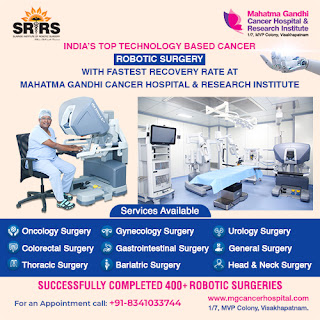BONE MARROW TRANSPLANTATION UNIT
For the FIRST time in the state of Andhra Pradesh by Mahatma Gandhi Cancer Hospital & Research institute
Mahatma Gandhi Cancer Hospital & Research Institute, Visakhapatnam which has been in health care service for more than 18+ years, is the largest Comprehensive Exclusive Cancer Specialty hospital in Andhra Pradesh with the largest team of qualified cancer super specialists under one roof drawn from all premium institutes in India. We are equipped with cutting-edge technology for patient-centric oncology care with an evidence-based medical practice ranging from prevention, early detection, cancer treatment, and terminal care.
Bone Marrow Transplant (BMT) Unit: Mahatma Gandhi Cancer Hospital & Research Institute has launched its state-of-the-art Bone Marrow Transplant (BMT) facility at Health City, Arilova, and Visakhapatnam BMT unit in Andhra Pradesh. Mahatma Gandhi Cancer Hospital & Research Institute completed successfully 100+ BMT cases. The unit has four transplant cubicles for transplant patients' use before and after the procedure. All cubicles are of class-10000 cleanroom standard and with HEPA filtration systems and position pressure ventilation.
The transplant programme team provide specialized service under Hemato-oncology department. The team committed to providing quality service all children & adults needing this procedure.
 |
| best cancer hospital in Vizag |
About Bone Marrow:
Bone Marrow is the soft and spongy tissue found within bones which is rich in stem cell The most primitive of these stem cells are the pluripotent stem cells, which are different from the other cells in the following aspects:
· They produce cells identical to themselves
· They have the capacity to produce one or more subsets of mature cells.
These stem cells are of prime importance in Bone Marrow Transplant, which is m appropriately known in clinical terminology as Hematopoietic Stem Cell Transplant (HSCT).
Other sources of stem cells have gained popularity in the last decade, because their harvesting is better tolerated by donor while delivering almost identical success rates when compare Bone Marrow Transplant. These include Peripheral Blood Stem Cells and Cord Blood Stem Cells.
What is Bone Marrow Transplant?
Bone Marrow Transplant procedure is performed not only for cancerous conditions like blood cancer but also for genetic condition like Thalassemia. Here, the cancerous or genetically abnormal stem cells are eradicated by chemotherapy and immuno-suppressive medicines new functionally normal stem cells are given which later populate the bone marrow and b with normal non-cancerous cells and genetically normal cells.
Some Conditions which require Bone Marrow Transplant (BMT):
The conditions which necessitate a Bone Marrow Transplant (BMT) can be broad classified into 2 groups:
Cancerous Conditions:
• Acute Myeloid and Lymphoblastic Leukemia
• Chronic Myeloid and Lymphocytic Leukemia
• Relapsed Hodgkin's and Non-Hodgkin's Lymphoma
• Myelodysplastic Syndrome
• Myeloproliferative Neoplasms (Primary Myelofibrosis, etc.)
• Multiple Myeloma
Non-Cancerous Conditions:
• Aplastic Anemia
• Haemoglobinopathies such as Thalassemia and sickle cell Anemia
• Immunodeficiency’s disorders
• Inborn errors of metabolism
• Storage disorders
Procedure of Stem Cell Transplant:
Before stem cell transplant, stem cells are collected from either the bone marrow or blood. Patient is given high doses of chemotherapy, usually over a few days. Sometime radiotherapy is also given to the whole body, known as total body irradiation (TBI).This process is known as "conditioning".
As well as destroying any remaining cancer cells, the high doses of chemotherapy also destroy the stem cells in the bone marrow. After the chemotherapy, patient is given stem cells that were collected before the treatment. These stem cells start produce mature blood cells again.
AUTOLOGOUS BONE MARROW TRANSPLANT
Types of transplant - There are TWO main types:
A. Autologous BMT:
In this procedure, patients own stem cells are collected and these stem cells are after the high-dose treatment.
B. Allogeneic BMT:
This uses stem cells from a donor and is also known as an allograft. An allogeneic transplant is a more complicated procedure than an autologous one and only occurs in a very few specialized hospitals in India. Recovery may take several months longer. The donor is another person whose tissue has the same genetic type) as the person needing the transplant (recipient). It is more likely that the recipient will find a suitable donor in a brother or sister. This however, happens 25 to 30 percent of the time.
If a family member does not match the recipient, the request is sent to the un bone marrow transplant registry database to look for a suitable unrelated in whose tissue type is a close match. It is more likely that a donor who comes from the same racial or ethnic group as the recipient will have the same HLA type.
Steps involved in Bone Marrow Transplant:
1. Peripheral Blood Stem Cell Collection:
The Peripheral Blood Stem Cell Transplant method is more commonly performed when compared to the Bone Marrow Harvest method and it is less invasive and perform. Some studies even suggest that the stem cell yield by this method when compared to bone marrow harvest. The process takes 4-6 hours administering necessary medication for 4 days.
Donors are injected with Granulocyte Colony Stimulating Factor (GCSF) for a duration of 4 days to stimulate stem cell proliferation. The donor stem cells are collected by a process called apheresis.
2. Conditioning of the Patient:
The conditioning process involves high doses of chemotherapy and sometimes radiation. It is carried out for three reasons:
• Destruction of the existing bone marrow cells to make room for the transplanted stem cells
• Destroy any existing cancer cells
• Suppression of activity of the immune system to decrease chances of rejection of donor stem cells.
3. Transplanting the Stem Cells:
The process of Bone Marrow Transplant does not involve the physical insertion of the marrow stem cells into the marrow of the recipient. It is more of an intricate and delicate blood transfusion method. The harvested stem cells are administered via a central venous catheter into the bloodstream. The donor stem cells have the property of stem cell homing whereby they migrate to the patient's bone marrow and override his defective stem cells. This restores the ability of the patient's bone marrow to produce blood elements.
Risks of Bone Marrow Transplant (BMT):
1. Graft versus host disease (GvHD) In this disease, the transplanted stem cells ("graft") attack the recipient's cells ("host") as they are recognized as alien cells.
There are two types of GvHD: Acute GvHD-Occurs during the three months following the transplant Chronic GVHD Develops a 3 months and can cause symptoms many years.
2. Infections
As a consequence of chemotherapy bone marrow suppression, the body is transiently unable to procedure cell combat infections.


Dr. Rajit Rattan is one of the most loved oncologist in Chandigarh due to his sympathetic support for cancer patients. He provides full care – from determining the issue to the healing process taking into account the body and mind. From Dr. Rattan, the clients are offered innovative and personalized treatment to suit their conditions.
ReplyDeleteThis comment has been removed by the author.
ReplyDeleteBone Marrow Transplant Cost - Are you looking for bone marrow transplant in India. Bone marrow transplant (BMT) is a medical procedure to replace damaged or diseased bone marrow with healthy stem cells. Bone marrow transplant (BMT) is used to treat cancers like leukemia and lymphoma, as well as other blood disorders. The transplant restores the body’s ability to produce healthy blood cells and strengthen the immune system. Visit: Best Bone Marrow Transplant Hospitals in India
ReplyDeleteTop Bone Marrow Transplant in India
Healthcare Tourism Company in India